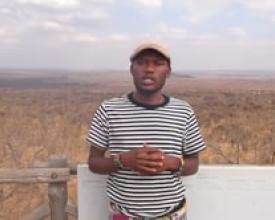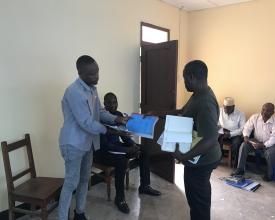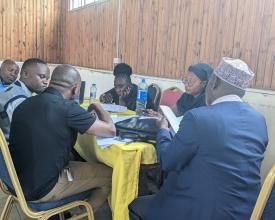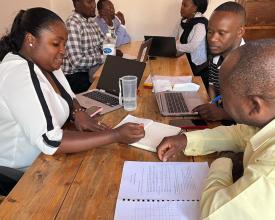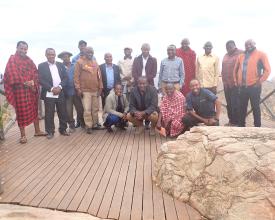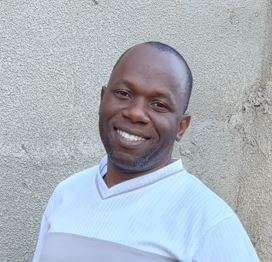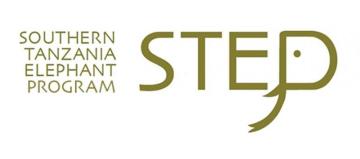
Professionalizing Wildlife Management Areas’ Governance: The MBOMIPA Model for Sustainable Conservation
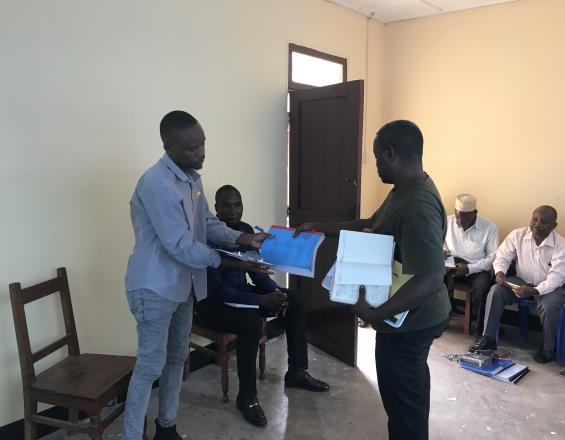
MBOMIPA Wildlife Management Area (WMA), a key conservation site in Tanzania’s Ruaha-Rungwa ecosystem, faced governance and management challenges, including unclear oversight roles and limited capacity. Supported by the European Union and the Organisation of African, Caribbean, and Pacific States through the BIOPAMA Programme, STEP and its partners implemented a project in 2023–2024 to strengthen the WMA. This included recruiting a professional management team, training 150 leaders (Authorized Association members, Board members, and village officials), and developing 10 governance tools. Key reforms focused on clarifying roles, improving financial oversight, and enhancing stakeholder engagement. These efforts led to significant conservation and economic gains, attracting two investors and increasing revenue by 25% compared to pre-project levels. Community benefits also grew substantially, with village dividends rising from $500 in 2023 to ten times that amount in 2024, funding schools, clinics, and women’s groups
Context
Challenges addressed
The MBOMIPA WMA faced critical governance, capacity, and financial challenges that hindered effective conservation and community benefits. Governance: Blurred roles between management and oversight bodies led to inefficiencies and weakened accountability. Capacity: The WMA lacked skilled personnel and tools for wildlife monitoring, financial management, and stakeholder engagement. Economic: Limited revenue streams and investor interest restricted funding for conservation and community dividends. Social: Low community trust in leadership and limited participation in decision-making weakened local support for conservation. Addressing these challenges was essential to transforming MBOMIPA into a sustainable, community-driven conservation model.
Location
Process
Summary of the process
MBOMIPA's solution creates an integrated governance system where professional management, governance tools, and oversight mechanisms reinforce each other. The professional team implements standardized tools like financial systems and policy frameworks, while oversight bodies provide strategic guidance. This creates a continuous improvement cycle - managers apply tools in daily operations, oversight refines processes, and peer-learning introduces best practices. The tools provide operational structure while allowing local adaptation, with oversight ensuring community alignment. Management's skills enhance tool use, the tools enable consistent operations, and oversight maintains long-term vision. Together, these components establish transparent, effective governance that balances conservation and community needs through their complementary functions and feedback loops, creating impact greater than any single element could achieve.
Building Blocks
Professional Management Recruitment and Training
This building block focused on recruiting and training a professional management team (initially the General Secretary and Accountant) for MBOMIPA WMA to enhance its operational efficiency. The team comprises individuals with expertise in conservation, financial management, and community engagement, ensuring a holistic approach to managing the WMA. Soon after recruitment, six weeks of the onboarding commenced with the training sessions conducted on governance best practices, financial reporting using QuickBooks, and other resources such as human and assets management. These trainings equipped the management team to handle day-to-day operations, engage with stakeholders effectively, and ensure sustainable management of natural resources. The professional team was tasked with coordinating patrols, managing budgets, and improving the overall governance of the WMA.
Enabling factors
- Collaboration with other organizations: Support from STEP, Tanzania TAWA, and Honeyguide Foundation in recruitment, coaching, and training.
- Availability of local and international trainers with expertise in conservation and financial management.
- Local communities’ collaboration: Collaboration with local communities for identifying suitable candidates who understand the landscape and community needs.
Lesson learned
- Recruiting professionals with diverse skill sets significantly improves operational efficiency and builds stakeholder confidence.
- Continuous training and mentorship are crucial to maintaining high performance and adapting to new challenges.
- Integrating conservation technologies and financial tools enhances transparency, data-driven decision-making, and resource management.
Development and Implementation of Governance Tools
This building block aimed to establish a robust governance framework through the development and implementation of essential management tools. Financial management systems, such as QuickBooks, were introduced to streamline budgeting, accounting, and financial reporting. Additionally, standardized reporting templates and monitoring frameworks, along with key management tools such as the Code of Conduct, Human Resources Manual, Gender Policy, Environmental Policy, Court Policy, Procurement Policy, Dispute Resolution Manual, Stakeholder Engagement Plan, and Business Entrepreneurship Sustainability Tool were developed to ensure effective resource management in the WMA. These tools promote adherence to human rights, enhance data collection and evaluation, ensure transparent communication with stakeholders, foster meaningful engagement, incorporate gender considerations, and support sustainable business practices. Their integration has significantly improved financial accountability, operational transparency, and decision-making, thereby fostering trust among community members and external stakeholders.
Enabling factors
- Collaboration with Honeyguide Foundation, Community Wildlife Management Area Consortium, Iringa District Council, and TAWA in the development and customization of governance tools.
- Technical support from STEP to train staff on the use and maintenance of financial and monitoring systems.
- Continuous feedback from AA members, Board of Trustee, and community representatives to ensure the tools meet their needs and remain relevant.
Lesson learned
- Governance tools must be user-friendly to encourage consistent use by the management team and stakeholders.
- Regular updates and maintenance are necessary to ensure the tools remain effective and aligned with evolving needs.
- Providing ongoing technical support and refresher training is critical for successful implementation and long-term sustainability.
Strengthening Oversight by the Authorized Association and Board of Trustees
This building block strengthened governance by enhancing the oversight capacity of MBOMIPA WMA’s Authorized Association (AA) and Board of Trustees through structured peer-learning and institutional reforms. A 5-day exchange visit to Randilen WMA (that has been considered as one of economically viable WMA in the Northern Tanzania being valued by their constituent communities) enabled 21 WMA leaders to adopt proven practices, including clear role separation (Board/AA/Management), financial oversight tools (Ministry of Natural Resources and Tourism Portal, invoicing systems), and community engagement strategies (equitable benefit-sharing and conflict resolution). Post-visit evaluation revealed 92.5% of leaders demonstrated improved governance knowledge and 85% noted enhanced transparency. Key outcomes included a development of MBOMIPA WMA Board Constitution and a 25% revenue increase from new tourism investments ensuring accountable management and aligned conservation-community goals.
Enabling factors
- Regular support and facilitation by Iringa District Council, STEP, and other conservation partners.
- Availability of peer-learning opportunities with other WMAs that have successfully implemented similar governance structures.
- Engagement of local leaders and community representatives to ensure alignment with community needs and expectations.
Lesson learned
- Clear separation of roles and responsibilities between management and oversight bodies enhances governance efficiency.
- Regular communication and collaborative decision-making between the management team, AA, and Board of Trustees build community trust and improve transparency.
- Continuous capacity-building and leadership development are essential for maintaining effective oversight and adapting to emerging challenges.
Impacts
The project has delivered significant governance/social and economic impacts in the MBOMIPA WMA. Governance/Social: Transparent governance improved, with 92.5% of 49 leaders passing competency tests and 85% of villagers noting better accountability. Women held 40% of leadership roles, and over 15,600 residents joined conservation campaigns like the MBOMIPA Cup. Economic: Revenue grew by 25% in 2024 from pre-project level, enabling $5,000 dividents/village supporting schools, toilets, and teacher housing. New tourism investments created jobs, while governance tools (Site-level Assessment of Governance and Equity reports, Stakeholder Engagement Plan, Human-Wildlife Conflict Strategy, Business Enterprises Sustainability Tool) and partnerships (e.g., Randilen WMA) offer scalable models for Tanzania’s WMA network.
Beneficiaries
Direct beneficiaries include 150 leaders (AA members, Board, and village leaders) gained governance skills, professional WMA team trained, and 74,360+ locals benefit from jobs, tourism revenue (schools, clinics) while women hold 40% leadership.
Global Biodiversity Framework (GBF)
Sustainable Development Goals
Story
In 2023, MBOMIPA WMA faced governance challenges that hindered effective management of the protected area. The roles of the management team, Authorised Association (AA), and Board of Trustee were unclear, leading to overlapping responsibilities and delayed decision-making.
Recognizing the need for change, STEP supported the WMA in recruiting a professional management team, initially the General Secretary and Accountant. These individuals were trained in financial and human resources management, governance, and conservation planning, using tools such as QuickBooks for financial reporting, developed policies and management manuals.
One notable success was the development and implementation of a 10-year General Management Plan. With the management team focusing on daily operations, the AA and Board of Trustee were able to concentrate on strategic oversight and stakeholder engagement.
This clear division of roles resulted in improved financial accountability, timely reporting, and increased community participation in governance meetings. The WMA also attracted two new investors, generating revenue that was distributed to member villages, supporting education, healthcare, and infrastructure projects.

